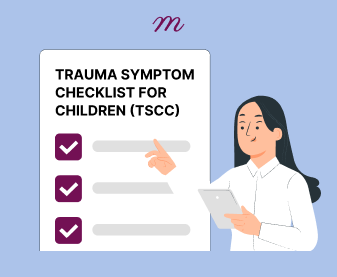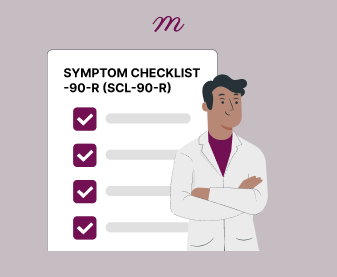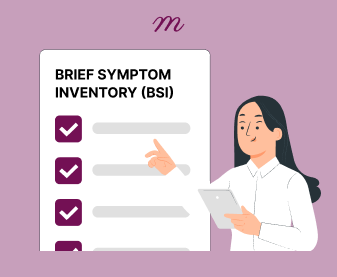Have your progress notes written for you automatically
Childhood trauma leaves deep emotional and psychological scars, often manifesting in ways that can profoundly affect a child’s development and well-being. It can shape the way they regulate emotions, form relationships, and even impact their physical health. For therapists, the stakes are high—early identification and intervention can make all the difference in helping a child heal and thrive.
However, identifying trauma in children is not always straightforward. Many struggle to articulate their experiences, while others may not fully understand what they’ve suffered. This is where tools like the Trauma Symptom Checklist for Children (TSCC) become invaluable. An evidence-based, reliable instrument, the TSCC offers a structured way to assess trauma symptoms and gain deeper insights into a child’s emotional world. In this article, we delve into the TSCC’s significance, structure, and application.
Exploring the Trauma Symptom Checklist for Children (TSCC)
The Trauma Symptom Checklist for Children (TSCC) is a comprehensive, evidence-based psychological assessment tool designed to evaluate trauma-related symptoms in children and adolescents aged 8 to 16. Developed by John Briere in 1996 [1], this instrument bridges a significant gap in trauma assessment by providing a reliable method to identify emotional and psychological disturbances stemming from adverse childhood experiences.
The TSC is part of a broader family of tools, including the Trauma Symptom Checklist for adults (TSC) and the Trauma Symptom Checklist for Young Children (TSCYC) [2]. The TSCYC is specifically tailored for younger children aged 3 to 12 and relies on caregiver reports to evaluate trauma symptoms. This ensures that clinicians can effectively assess trauma across a wider age range, accommodating developmental and communication differences between younger and older children.
The TSCC’s comprehensive design enables clinicians to pinpoint specific areas of concern, such as dissociation or anger, which might otherwise be overlooked. Additionally, its utility extends beyond diagnostic purposes; it facilitates communication with children, helping them articulate their feelings and experiences. For therapists, this can be the first step in building a trusting relationship and developing tailored intervention strategies.
In summary, the Trauma Symptom Checklist for Children is more than just a diagnostic tool. It is a gateway to understanding the multifaceted impacts of trauma, empowering therapists to provide targeted, effective care that helps children navigate their path to healing.
Key Features and Structure of the TSCC
Understanding the nuances of trauma in children requires tools that are both reliable and adaptable. The TSCC achieves this by addressing the complex manifestations of trauma through a meticulously crafted design. Below, we explore the key features of this tool that make it indispensable in clinical practice [1].
1. Target Age Group
The TSCC is specifically designed for children aged 8 to 16. This age range captures a critical developmental window where trauma symptoms may be both pronounced and detectable. The tool’s language and concepts are age-appropriate, ensuring that even younger children within this range can understand and respond meaningfully.
2. Comprehensive Symptom Domains
One of the TSCC’s standout features is its ability to assess a broad spectrum of trauma symptoms with its 54 items. It includes six clinical subscales:
- Anxiety: Gauging heightened fears and worry.
- Depression: Identifying sadness, hopelessness, and withdrawal.
- Anger: Assessing irritability and aggression.
- Dissociation: Highlighting feelings of detachment from reality.
- Post-Traumatic Stress: Tracking flashbacks, hypervigilance, and avoidance behaviors.
- Sexual Concerns: Capturing inappropriate sexual behaviors or thoughts often linked to sexual abuse. These domains provide therapists with a multidimensional understanding of how trauma uniquely impacts each child.
It also has two validity scales to identify under-response and hyper-response tendencies and eight critical items that examine situations that may require follow-up, such as suicidality. Its structure allows therapists to assess both the intensity and frequency of trauma symptoms.
3. Scoring System and Interpretation
The TSCC employs a 4-point Likert scale (0 = never to 3 = almost all the time) for each item, enabling nuanced insights into the frequency and intensity of symptoms. Higher scores in any domain signal clinically significant distress, guiding therapists toward targeted interventions. The straightforward scoring system makes it user-friendly for practitioners.
4. Tested Across Populations
Originally developed in Western contexts, the TSC has been rigorously tested across diverse populations to ensure its reliability and validity. These studies confirm its relevance in global clinical practices, making it a trusted tool for therapists working with children from various cultural and demographic backgrounds [3].
5. Efficient Administration
Time efficiency is key in clinical settings, and the TSCC’s 10-20 minute administration time makes it practical without compromising depth. It can be easily integrated into standard therapy sessions, reducing barriers to comprehensive assessment.
6. Integration with Other Tools
The TSC does not work in isolation. It’s often paired with tools like the Child Behavior Checklist (CBCL) or structured clinical interviews to create a more complete picture of a child’s mental health. This integration maximizes diagnostic accuracy and informs holistic treatment plans.
7. Validity and Reliability
The TSC has demonstrated strong psychometric properties, with studies confirming its high internal consistency and reliability across clinical and non-clinical samples. Research highlights its ability to accurately differentiate between trauma-exposed and non-trauma-exposed children, supporting its utility in diverse settings. Its validity is further reinforced by its alignment with other established measures, such as the Child Behavior Checklist (CBCL), providing therapists with confidence in its diagnostic precision.
Challenges and Limitations of the TSC
While the Trauma Symptom Checklist (TSC) is a valuable tool for identifying trauma symptoms in children, it does come with certain limitations that therapists need to be mindful of. A thorough understanding of these challenges ensures that the tool is used effectively and ethically in clinical practice.
1. Navigating the Self-Reporting Challenge
Children—especially younger ones—often struggle to articulate their emotions or understand complex psychological states. This can result in inaccurate or incomplete self-reports. A child may underreport symptoms due to fear, shame, or a lack of understanding, which could lead to misdiagnosis or missed opportunities for intervention. Therapists must establish trust and create a safe space where children feel comfortable sharing their experiences.
2. The Cultural Conundrum
While the TSC has been tested across diverse populations, cultural nuances can still pose challenges. For example, expressions of trauma may differ depending on cultural norms, leading to potential misinterpretations of symptoms. Therapists should approach each assessment with cultural sensitivity, ensuring they understand the child’s background and context.
3. Parental Hesitations
Resistance from parents or caregivers can be a significant barrier. Some may fear the stigma associated with trauma or worry about what the results might imply for their parenting. Open communication is key. Uunderstanding a child’s needs can lead to targeted, effective support.
4. Limited Exploration of Root Causes
The TSC is exceptional at identifying symptoms but doesn’t delve deeply into the underlying causes of trauma. This limitation underscores the need for supplementary assessments and interviews to build a comprehensive understanding of the child’s experiences and the factors contributing to their distress.
5. Risk of Over-Reliance on Scores
While the TSC provides valuable data, there’s a risk of focusing solely on scores without considering the bigger picture. Trauma is complex and multifaceted, and numerical results should be integrated with clinical observations, caregiver input, and the child’s own narrative to form a holistic view.
6. Balancing Reliability and Context
Though the TSC has high reliability, factors like recent stressful events or the child’s mood on the day of assessment can influence results. Reassessments over time and cross-referencing with other tools can help ensure a more accurate picture.
Turning Challenges into Opportunities
To overcome these challenges, therapists can:
- Combine Tools: Pair the TSC with complementary assessments like caregiver interviews or the Child Behavior Checklist (CBCL) for a more rounded view.
- Emphasize Cultural Competence: Continually educate themselves on cultural factors that might influence trauma expressions and interpretations.
- Engage Caregivers: Involve parents or caregivers as partners in the process, addressing their concerns and helping them understand the value of trauma assessments.
- Invest in Training: Regular training on administering and interpreting the TSC ensures that therapists maximize its potential while avoiding common pitfalls.
By addressing these limitations with intentional strategies, therapists can unlock the full potential of the TSC, ensuring it serves as a reliable ally in the journey toward healing and resilience for trauma-affected children.
Case Example: TSC in Action
Stories often bring data and methods to life, and this example illustrates how the Trauma Symptom Checklist for Children (TSCC) can guide transformative interventions.
Jake’s Path: Rebuilding Safety After Trauma
Nine-year-old Jake’s world had been turned upside down following a severe car accident. He displayed classic trauma responses, including dissociation and hypervigilance. Jake’s TSCC results highlighted significant concerns in these areas, giving his therapist valuable guidance for tailoring his treatment.
The therapist introduced trauma-focused therapy, gradually helping Jake process his memories of the accident in a controlled and supportive environment. Gradual exposure techniques were employed to rebuild his sense of safety—from practicing calm breathing exercises during car rides to using visualization techniques that allowed Jake to imagine himself safe and secure. The therapist also involved Jake’s parents in the process, teaching them strategies to reinforce his coping skills at home. Over time, Jake’s dissociative episodes and hypervigilance decreased, allowing him to re-engage with the world around him.
What Jake’s Story Teaches Us
Jake’s story underscores the versatility and power of the TSCC in guiding effective, individualized interventions. By pinpointing specific areas of distress, therapists can move beyond generalizations and craft treatment plans that directly address each child’s unique needs. This example highlights how the TSCC doesn’t just identify symptoms—it creates a pathway to healing, growth, and resilience.
Conclusion: The TSCC as a Catalyst for Healing
Childhood trauma is a profound challenge, but tools like the Trauma Symptom Checklist for Children (TSCC) offer hope for therapists and children alike. By systematically identifying the specific ways trauma manifests in a child’s emotional and psychological world, the TSCC equips clinicians with actionable insights that pave the way for targeted, meaningful interventions. Its evidence-based design, adaptability across cultures, and ease of use make it an indispensable resource in understanding and addressing the complex layers of childhood trauma.
As therapists, our mission goes beyond alleviating symptoms—it is about empowering children to reclaim their sense of safety, connection, and self-worth. The TSCC not only aids in early identification but also lays the groundwork for transformative healing journeys. By integrating this powerful tool into clinical practice, therapists can make a lasting impact, helping children not just survive their trauma but truly thrive in the face of adversity.
References
[1] Briere, J. (1996) Trauma Symptom Checklist for Children: Professional Manual. Psychological Assessment Resources Inc.
[2] Briere, J., Johnson, K., Bissada, A., Damon, L., Crouch, J., Gil, E., Hanson, R., & Ernst, V. (2001). The Trauma Symptom Checklist for Young Children (TSCYC): reliability and association with abuse exposure in a multi-site study. Child abuse & neglect, 25(8), 1001–1014. https://doi.org/10.1016/s0145-2134(01)00253-8
[3] Morelli, N. M., Elson, D., Duong, J. B., Evans, M. C., & Villodas, M. T. (2021). Examining the Factor Structure and Measurement Invariance of the Trauma Symptom Checklist for Children in a Diverse Sample of Trauma-Exposed Adolescents. Assessment, 28(5), 1471-1487. https://doi.org/10.1177/1073191120939158










